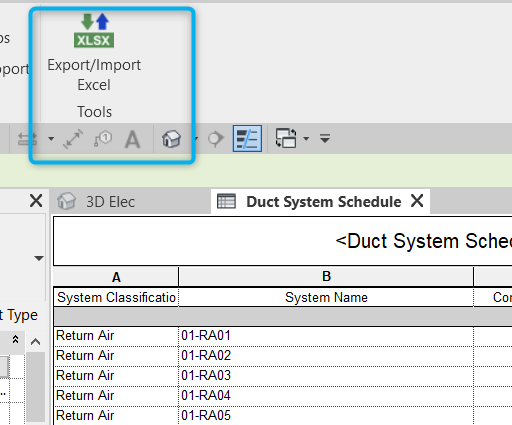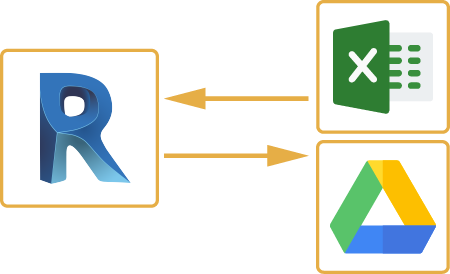Elevate Your Design Video Game with Crucial Revit Add Ins
Wiki Article
Breaking Barriers: Excel Importation Techniques for Advanced Revit Users
Discover different data importation techniques and master Excel integration to boost your Revit modeling capabilities. With our pointers and techniques, you can conquer importation obstacles and end up being a real professional in making use of Excel for your Revit jobs.Advanced Revit Users: Leveraging Excel for Importation
You can conveniently leverage Excel for importation as a sophisticated Revit customer. Excel is an effective tool that can greatly improve your operations and efficiency in Revit. With its capacity to take care of huge quantities of information and carry out intricate calculations, Excel can be an useful property in handling and arranging your project info.One means to leverage Excel for importation is by utilizing the "Web link Excel" feature in Revit. This attribute allows you to link an Excel spread sheet directly into your Revit job, allowing you to upgrade and synchronize information in between both programs. When dealing with routines or tracking modifications in your task., this can be specifically beneficial.
Another method to use Excel is by utilizing the "Import/Export" feature in Revit. This function enables you to import and export data in between Revit and Excel, offering you the versatility to collaborate with information in both programs. You can import information from Excel right into Revit to develop components such as rooms, wall surfaces, or doors, and you can additionally export data from Revit to Excel for additional analysis or reporting.

Exploring Information Importation Methods in Revit Using Excel
Checking out exactly how to import data from Excel right into Revit supplies reliable approaches for incorporating info. When you import data from Excel, you can effortlessly transfer data such as room schedules, product listings, and tools information right into your Revit task. This procedure permits you to conserve effort and time by staying clear of hand-operated information entrance.To import data from Excel into Revit, you can utilize the "Import/Export" feature. This feature allows you to map the Excel information areas to the matching Revit criteria, making certain that the information is correctly appointed within the version. By choosing the proper import options, you can manage exactly how the information is imported and exactly how it connects with your task.
Another approach for importing information from Excel right into Revit is by utilizing Eager beaver. Dynamo is a visual shows device that integrates with Revit and allows you to automate workflows and jobs. With Dynamo, you can create customized manuscripts that import information from Excel and adjust it within your Revit project. This method provides a lot more flexibility and customization options.
Mastering Excel Combination for Advanced Revit Modeling
One key technique is importing information from Excel spread sheets directly into your Revit design. With a couple of simple actions, you can map the Excel columns to the corresponding Revit specifications and import the information properly.Another helpful technique is exporting information from Revit to Excel. This allows you to extract info from your model, such as timetables or material quantities, and examine it in Excel using formulas, charts, or other effective tools. By leveraging the abilities of Excel, you can execute complex calculations, create personalized records, and gain valuable insights into your project.
Along with data transfer, Excel integration can automate recurring jobs in Revit. By developing macros or manuscripts in Excel, you can automate procedures like developing sights, producing sheets, or applying conventional families - revit get more tool. This not just conserves time however likewise makes sure consistency across your job
To master Excel integration in Revit, it is essential to understand the data framework and just how Revit connects with Excel. By acquainting on your own with the offered tools and strategies, you can unlock the complete possibility of Excel combination and take your Revit modeling to the following degree.
Overcoming Importation Difficulties: Excel Techniques for Revit Professionals
When getting over importation difficulties, it's vital to be familiar with efficient Excel strategies that can benefit specialists in Revit. As a sophisticated Revit user, you comprehend the importance of effortlessly importing data from Excel right into your jobs.
Another helpful strategy is using the "Transpose" function in Excel. This permits you to convert data from rows to columns or the other way around. When importing data into Revit, this can be specifically valuable when you have information in a vertical layout in Excel, yet you need it to be in a horizontal layout in Revit.
have a peek here Furthermore, using Excel solutions such as VLOOKUP and INDEX-MATCH can considerably aid in mapping information from Excel to Revit. These solutions allow you to look for certain worths in Excel and recover matching information from another column. This can save you time and initiative when importing large datasets into Revit.
Excel Information Importation Tips and Tricks for Advanced Revit Users
By acquainting on your own with reliable Excel techniques and tips, you can boost your data importation procedure as an advanced customer of Revit. Excel is a powerful device that can significantly promote the importation of data right into Revit, conserving you time and boosting your performance. One beneficial idea is to use the "Text to Columns" function in Excel to divide data right into various columns based on a delimiter. When you have data in a solitary column that needs to be divided right into several columns in Revit, this can be especially valuable. Additionally, using Excel's "Paste Unique" feature enables you to paste data from Excel right into Revit click here to find out more while keeping format, such as cell color or font style. When importing information that calls for specific formatting in Revit, this can be especially beneficial. Another helpful technique is to make use of Excel's "Locate and Replace" function to rapidly make modifications to your data before importing it into Revit. You can quickly replace specific text or characters with others, saving you the time and effort of manually editing the data in Revit. By utilizing these Excel suggestions and techniques, you can improve your data importation process and end up being much more proficient in operation Revit.
Verdict
You have actually now found out useful techniques for importing data from Excel right into Revit as a sophisticated user. Go ahead, damage those barriers and succeed in your Revit projects!
When importing information into Revit, this can be specifically useful when you have information in an upright layout in Excel, but you require it to be in a straight format in Revit.
Moreover, utilizing Excel formulas such as VLOOKUP and INDEX-MATCH can substantially assist in mapping data from Excel to Revit. In addition, making use of Excel's "Paste Special" function permits you to paste data from Excel right into Revit while maintaining formatting, such as cell shade or font design.
Report this wiki page